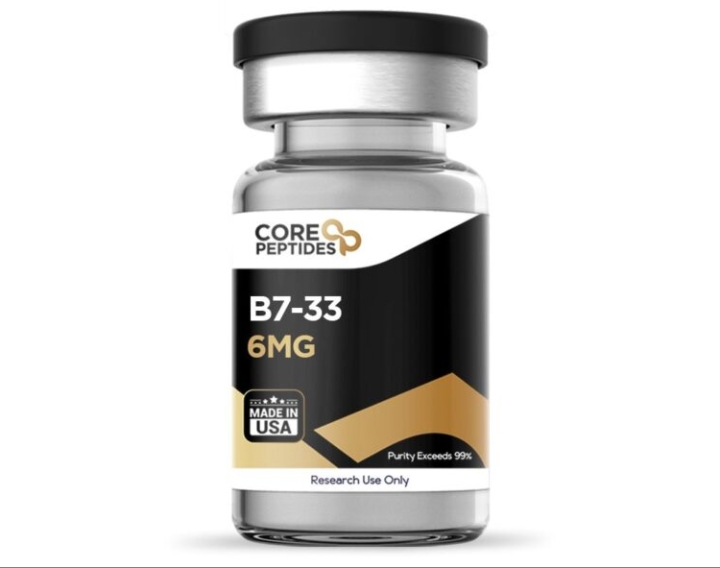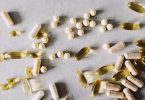In today’s article, we will discuss the biological applications of the B7-33 peptide. If you want to learn more about this topic, keep reading.
Tissues become abnormally thick or deteriorate in patients with fibrosis. Those experiencing the “end stage” of severe, chronic diseases are more likely to develop fibrosis.
Although fibrosis can be treated in a variety of ways, from medication to surgery, it was shown in a clinical experiment in 2012 that a protein called H2-relaxin prevented the development of permanent scarring in the heart as a result of injury [v].
The natural protein H2-relaxin has a synthetic equivalent known as B7-33 peptide. According to research, B7-33, like H2-relaxin, has anti-fibrotic qualities and the other apparent benefits we will list below.
B7-33 Peptide: What Is It?
One chain peptide B7-33 is a shorter, structurally similar version of the naturally occurring relaxin protein [ii].
Four subunits comprise the relaxin peptide: the signal peptide, the B chain, the C chain, and the COOH terminus.
Several early attempts to duplicate these peptide structures failed miserably due to the difficulty of achieving solubility and activity.
Studies show that the B7-33 peptide was the first soluble analog resulting from structural modifications made by scientists in 2016 after years of study. These included the production of a B chain and the extension of the COOH terminus [ii].
Peptide Mechanism of Action
According to research, the peptide differs from native proteins in structure and a few other ways that are somewhat helpful, especially when compared to H2-relaxin.
Studies show that the cAMP pathway is bypassed by the B7-33 peptide, which instead exerts its effects via the pERK pathway.
Traditionally, H2-relaxin generates its anti-fibrotic activities via the cAMP pathway, which may promote tumor development. An essential negative impact of relaxin therapy [i].
The RXFP-1 receptors are also a target of high affinity for the peptide.
Research shows that the Matrix metalloproteinase-2 (MMP-2) chemical production is boosted after the peptide binds to RXFP-1 receptors and triggers the pERK pathway. Inhibiting scarring and avoiding fibrosis results from these pharmacological interventions [i].
B7-33 peptide has a variety of potential applications.
Studies on test subjects have shown that this peptide has practical medical applications.
- The ability to inhibit fibrotic growth
- The ability to prevent damage to blood vessels
- Aids in preeclampsia treatment
- Utilization as an adornment for inserted medical devices.
Evidence of Vasoprotective Effects
According to research, H2 relaxin’s efficacy against heart failure and fibrosis led to its recognition as a powerful vasoprotective medication.
However, due to the high price and time commitment of exogenous H2 relaxin production, it became increasingly vital to investigate whether its analog B7-33 peptide demonstrated the same effects.
Research shows that administering sodium acetate, H2 relaxin, or B7-33 into the tails of male Wistar rats was the method of choice for this study [iii], published in 2017.
These animals’ mesenteric artery, renal artery, and abdominal aorta were primarily analyzed after 3 hours.
Although neither B7-33 nor H2 relaxin demonstrated enhanced vasodilatory capabilities in the renal artery or abdominal aorta, they did in the mesenteric artery, as per study results.
In order to gain a deeper insight, a further investigation [iii] was conducted on female mice that were manipulated to have endothelium dysfunction in the lab. These mice were given H2 relaxin.
According to research results, both substances effectively reduced the severity of endothelial dysfunction and halted its progression in mice once therapy had concluded.
These findings demonstrate that B7-33 can prevent additional damage to blood vessels by mimicking the vasoprotective actions of H2 relaxin. The findings also suggest that the peptide has therapeutic promise for addressing cardiovascular disorders.
Prevention of Preeclampsia: Current Research
Preeclampsia is a condition of pregnancy marked by elevated maternal blood pressure and diminished fetal weight. This study [iv] aimed to investigate the efficacy of the B7-33 peptide in managing preeclampsia during pregnancy.
In this experiment, cytotrophoblasts (CTBs) were grown in the lab. A particular type of cell called cytotrophoblasts exists within the innermost layer of the embryo’s cells.
These cells were exposed to a placebo, steroid, or glucose for 2 days. After part of the cells were treated, they were exposed to a relaxin antagonist. B7-33 chemical was added to the cell culture medium, and all cells were treated.
Research showed that upon closer inspection, cells treated with B7-33 peptide were found to have increased levels of vascular endothelial growth factor (VEGF). Antibodies against relaxin decreased VEGF levels in treated cells.
Based on these findings, the peptide appears to have anti-glucose solid and anti-marinobufagenin properties, making it an effective tool in the fight against preeclampsia.
Investigations into Anti-Fibrotic Properties
H2 relaxin is a naturally occurring protein that inhibits scar tissue formation. The cAMP pathway is crucial to their operation. The full-length H2 relaxin protein strain has been proven in studies [v,vi] to increase heart rate and promote the spread of cancerous cells when administered to study participants. The primary explanation for this is that it works by stimulating the cAMP pathway.
Thus, scientists sought a variant that may generate the same anti-fibrosis biological effects without cAMP activation. The B7-33 peptide is the product of their research.
Mice with myocardial infarction were given the peptide, showing nearly a 50% reduction in heart tissue fibrosis. Overall, heart function increased, and problems diminished as a result.
Analyses revealed that the peptide’s success was primarily due to its ability to boost the body’s production of matrix metalloproteinase protein, which reduced the number of collagen-damaging cells and averted fibrosis.
Coating material studies show promise.
The immune system is primed to defend against intruders vigorously. Fibrosis is the primary mechanism by which the body rejects foreign objects, separating them so they cannot disrupt normal body function. This aspect is beneficial when dealing with antigens and disease-causing elements, but it becomes problematic when undergoing body implants.
For instance, the body may reject a cardiac stent since it is a foreign object, resulting in potentially fatal complications, including blockage and heart attack.
Adverse Reactions to B7-33 Peptide
Since B7-33 is still relatively new, there is much room for exploration and testing, as researchers reveal. Due to the ongoing trials, experts don’t know the full extent of potential adverse effects, but it’s reasonable to assume that some side effects will be typical of other peptides. There are several, but some effects, according to studies, are:
- Temporary pain and itching.
- Lack of salivation
- Dizziness
- Chills, fever, and other flu-like symptoms
- Hurting joints
You can find B7-33 for sale if you are a researcher interested in further studying the potential of this wonder peptide.
References
[i] Mohammed Akhter Hossain et al., A single-chain derivative of the relaxin hormone is a functionally selective agonist of the G protein-coupled receptor, RXFP1, Drug Discovery Biology Pharmacology Monash Biomedicine Discovery Institute, Vol 7, 2016. https://research.monash.edu/en/publications/a-single-chain-derivative-of-the-relaxin-hormone-is-a-functionall
[ii] Nitin A Patil et al., Relaxin family peptides: structure–activity relationship studies, British Pharmacological Society, vol 174 issue 10, published 06 December 2016. https://doi.org/10.1111/bph.13684
[iii] Marshall SA, O’Sullivan K, Ng HH, Bathgate RAD, Parry LJ, Hossain MA, Leo CH. B7-33 replicates the vasoprotective functions of human relaxin-2 (serelaxin). Eur J Pharmacol. 2017 Jul 15;807:190-197. doi: 10.1016/j.ejphar.2017.05.005. Epub 2017 May 3. PMID: 28478069. https://pubmed.ncbi.nlm.nih.gov/28478069/
[iv] S.H Afroze et al., Abstract P3042: Novel Peptide B7-33 and It’s Lipidated Derivative Protect Cytotrophoblasts From Preeclampsia Phenotype in a Cellular Model of the Syndrome, 4 Sep 2019. https://doi.org/10.1161/hyp.74.suppl_1.P3042
[v] Silvertown JD, Ng J, Sato T, Summerlee AJ, Medin JA. H2 relaxin overexpression increases in vivo prostate xenograft tumor growth and angiogenesis. Int J Cancer. 2006 Jan 1;118(1):62-73. https://pubmed.ncbi.nlm.nih.gov/16049981
[vi] Shu Feng, Irina U. Agoulnik, Natalia V. Bogatcheva, Aparna A. Kamat, Bernard Kwabi-Addo, Rile Li, Gustavo Ayala, Michael M. Ittmann and Alexander I. Agoulnik, Relaxin Promotes Prostate Cancer Progression, March 2007. https://clincancerres.aacrjournals.org/content/13/6/1695








